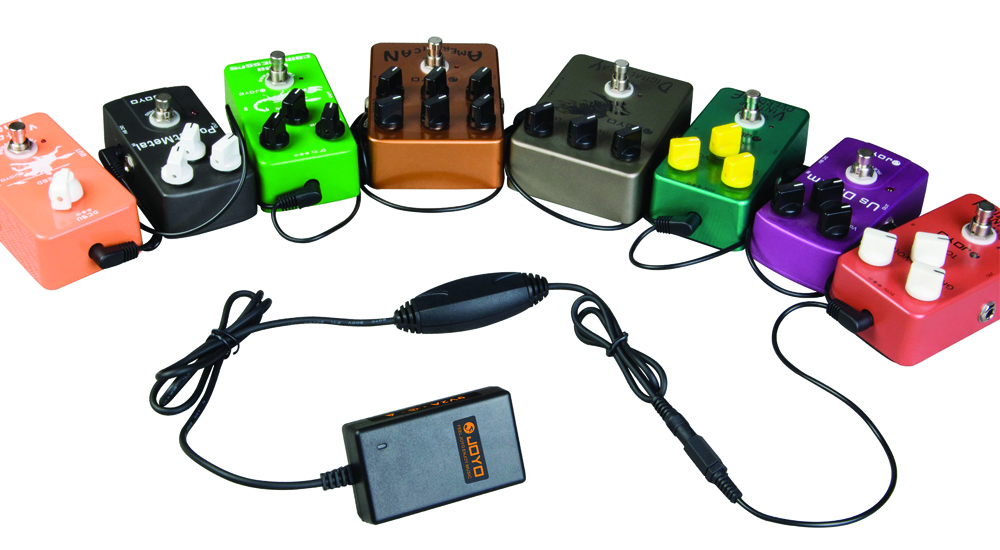VOLTAGE
Voltage measures the electrical potential between two points. It’s the pressure from point to point rather than the amount of electricity transferred, i.e. the current.
1 SPOT 9V Power Supply
In relation to supplying power to pedals, insufficient volts will result in a lack of energy and a pedal that won’t start. Conversely, too many volts can cause the effect to blow up with an inability to handle the strength of transferred electricity.
As a trailblazer in the stompbox industry, Boss unofficially created an industry standard of 9V DC (direct current). A 9V battery could power the majority of pedals, which made its role as a starting point a no-brainer and has seen it continue to be the adopted standard of power – a 9V power supply with the help of a daisy chain is a cheap and effective strategy to power a number of pedals at the same time.
Boss SD-1w Super Overdrive Power Input
However, there are some pedals for which a 9V simply won’t suffice, with certain brands requiring 12 of 18 volts of power. For these pedals manufacturers will often provide a specifically produced power supply, while isolated power supplies and pedal power bricks also offer the ability utilise these high-powered pedals.
The key point to remember is that the voltage of the pedal must match that of the power supply.
CURRENT
Current (mA) is used to express how much power is flowing from the power supply into the pedal. Many analogue pedals require less than 20mA, while digital units, equipped with a microprocessor or DSP, will generally demand greater than 150mA and up to several hundred.
Boss DD-500 Digital Delay
A stompbox that requires less mA than is being provided by the adaptor is no issue. Using an analogue distortion with 20mA connected to a power supply boasting 700mA will pose no danger.
On the other hand surpassing the available mA on a power supply will overwork the adapter and prevent it from turning on or cause it to abruptly turn off.
ALTERNATE CURRENT (AC) VS. DIRECT CURRENT (DC)
As we’ve already mentioned, the majority of effect pedals use DC, which involves the flow of electricity from the positive point on the outside to the negative point on the inside. On a standard DC Boss pedal the 2.1mm power input jack is thus equipped with a negative connector inside and positive one on the outside – what is referred to as centre negative polarity.
Electro-Harmonix AC Adaptor
In comparison, AC pedals can be manufactured with the positive connector in the middle – centre positive polarity – with an integrated rectifier that converts the AC power to DC power internally. The key the to remember is to always power a DC pedal with a DC power supply, and an AC pedal with an AC power supply, or otherwise risk the muddling up of wires and the destruction of your beloved stompbox.
ISOLATION
Isolation involves separating the power of each circuit from that of every other circuit in the signal chain, the benefit of which is to combat the poor interaction between different pedals when connected via a daisy chain and running through a single power supply.
Truetone 1Spot Pro CS7
The issue is often the result of ground loops that open the door for stray magnetic fields to enter your signal, thereby creating hum and unwanted noise. Additionally noise currents have the potential to be picked up by different pedals rather than simply flowing back into the power supply.
By introducing a digital delay pedal into a chain of analogue distortions and overdrives the digital noise dumped on the ground can be picked up by the analogue pedals, potentially diluting and disrupting the signal throughout the chain.
Voodoo Lab Pedal Power 2 Plus
Isolating power bricks such as the Voodoo Lab Iso 5 and the Truetone 1Spot Pro CS7 solve this issue with multiple-output isolated power. With the use of a transformer, or in some cases multiple transformers, these power supplies’ ensure that every power outlet is kept completely separate. The added bonus of which is an all-in-one fix without the clutter created by multiple adapters and the crossing of chords.
Isolation In Effect








